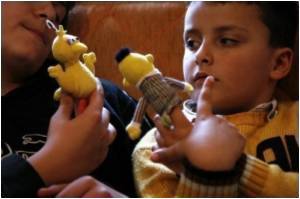Even if you aren't aware, the visual information from eyes is sent into the brain unconsciously.

The researchers previously showed blindsight in monkeys - monkeys with damage in the visual area of the brain are able to turn their eyes to 'unseen' visual stimuli. At this time, the research team examined whether blindsight occurs not only under the specific conditions of the laboratory, but also in everyday environments. They recorded eye movements of the blindsight monkeys freely watching video clips of everyday life scenes. They found that the monkeys were able to turn their eyes to the prominent portions in term of motion, brightness or color. By looking at eye movements of the monkeys with visual disability, we can understand where they pay attention to, although they do not see.
Assistant Professor YOSHIDA said, "this new finding indicates that blindsight can be used in everyday life of patients with hemianopia by cerebrovascular disorder. Then, there is the possibility that patients with visual impairment can recover their hidden visual function by rehabilitation." He also said "measurement of eye movements during viewing movie clips can be an efficient method to examine how well the patients can see unconsciouly".
Source-Eurekalert









